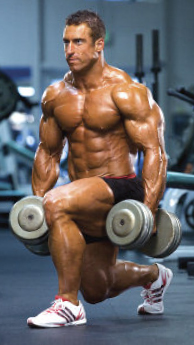CHAPTER 48
Asymmetric Training
“Dumbell training has helped me balance out my physique. Many of us have a muscular imbalance: perhaps one biceps is bigger than the other. My left biceps was half an inch smaller than my right, and I balanced them out with a unilateral routine.”
– Frank Sepe, regular MuscleMag International columnist
Ever notice how sore you get after you do something different, such as moving a piece of furniture … or even after a day of gardening? All those tons of weight lifted every day in the gym, yet one moved couch or dug flowerbed puts you in agony for three days. No wonder your relatives say muscle is only good for show! You get sore after doing something unusual such as moving a piece of heavy furniture because the movement is different than what you’re used to performing in the gym.
When was the last time you walked across the gym floor carrying a 50-pound weight? You may have shifted a 45-pound plate from the rack to a barbell or grabbed a dumbell off a rack and shifted to a bench, but you may never have actually carried a weight across the room. Likewise, how often do you climb up steps in the gym with a barbell on your shoulder?
These are not the type of movements you perform in your training, but they are the movements you often carry out in and around your house or apartment. Let’s look at it another way: how often during the day are your arms and legs performing identical movements at the exact same time? Few forms of physical activity outside the gym place equal stress on both sides of the body. In fact, just about the only time you employ bilateral movements is in the gym. Most weight-training exercises involve training both legs, arms, pecs, lats or other bilateral muscles at the same time, for example, barbell curls, squats, chin-ups, bench presses, lat pulldowns, etc.

Photo of Flex Wheeler by Alex Ardenti
Bodybuilders fear that asymmetrical training (training one side at a time) will produce an unbalanced-looking physique, with one side larger than the other. However, the opposite is more likely true. When you train both sides at the same time, your stronger side normally takes on more of the work to compensate for the weaker side. While machines are famous for allowing this to occur, it is also the case with barbells. The end result is a muscle on one side of the body that is slightly more developed than the matching muscle on the other side. Most bodybuilders have one leg or arm that’s slightly fuller than the opposing limb and this is often because of unequal stress experienced when training both legs or arms simultaneously.

Photo of Nathan DeTracy by Alex Ardenti
There are a number of advantages to training asymmetrically. Here are a few:
1 Keep Both Sides Equal. If you use a 50-pound dumbell for one-arm rows, you can be sure both sides are being subjected to the same 50 pounds. But the same can’t be said for front pulldowns. It’s possible that using say, 150-pounds on the stack could place 90 pounds on one side and only 60 on the other.
2 The All-Important Mind-Muscle Connection. This may sound self evident, but it’s much easier to concentrate on the working muscle when only one muscle is being worked. Here’s a little experiment for you to try the next time you’re in the gym. Do a set of barbell curls and try to concentrate on both biceps at the same time. Not easy, is it? Now grab a dumbell and do a set of concentration curls. Notice any difference? It’s much easier to concentrate on contracting one biceps muscle than both at the same time, and the mind-muscle connection can mean a huge difference in muscle gains.
3 Your Neuropathways. A third advantage to asymmetric training lies with neurobiology. There is some evidence to suggest that the brain has to split nerve impulses to stimulate both sides of the body at the same time. Training only one side at a time allows for full nervous stimulation of the muscle.
4 Time For a Change. If your body is used to training both sides at the same time, a few weeks of asymmetric training will produce the ideal shock to get it back to growing again.
Here are some of the best exercises to add variety to your training and to help correct muscle imbalances. Most of them are also terrific for working the core stabilizer muscles (abs, spinal erectors, etc.). Besides the following list, just about every exercise you can think of can be done asymmetrically. Just switch to a dumbell. However, I don’t recommend one-legged squats. As a word of caution, many of the following exercises will require you to twist your torso or lower body slightly to keep from falling over. Always pay attention to any warning signals that the body may give you. This is especially true in regard to the lower back. At the first instance of excessive spine pressure, reduce the weight, re-align your body or drop the exercise entirely. Remember to keep your core locked during all of these movements.

Asymmetrical training helps to ensure that you keep both sides equal, preventing muscle imbalances.
Photo of Branch Warren by Ralph DeHaan
Calves
One-leg toe presses
One-leg standing calf raises
One-leg seated calf raises
One-leg dumbell calf raises
Back
One-arm rows
One-arm lat pulldowns
Shoulders
One-arm front raises
One-arm lateral raises
One-arm reverse pec-deck
Triceps
One-arm dumbell kickbacks
One-arm cable kickbacks
One-arm dumbell extensions
One-arm triceps pushdowns
Quads
One-leg leg press
One-leg leg extensions
Lunges
Hamstrings
One-leg lying leg curls
One-leg seated leg curls
One-leg stiff-leg deadlifts
Chest
One-arm pec-deck flyes
One-arm flyes
One-arm dumbell presses
One-arm cable crossovers
Biceps
One-arm cable curls
One-arm dumbell curls
Concentration curls

Photo of Erik Fankhouser by Alex Ardenti